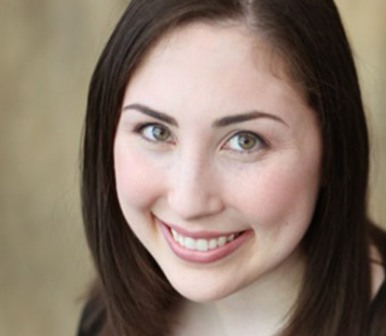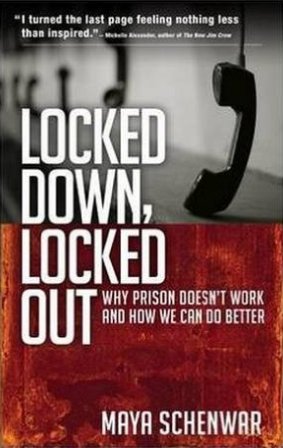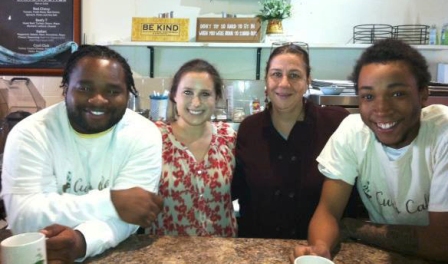 Maya Schenwar is Editor-in-Chief of Truthout – an independent social justice news website – and the author of the recent book Locked Down, Locked Out: Why Prison Doesn’t Work and How We Can Do Better. On Monday, March 7th, she will discuss her book when she visits EPL as part of the special program Unlocking America: How to Change Our Broken Prison System. Cosponsored by Chicago Books to Women in Prison and Cabrini Green Legal Aid, the program will also feature Dr. Crystal T. Laura who joins Schenwar to explore the impact of prison on families and advocate for a sweeping overhaul of our criminal justice system. In anticipation of this important discussion, we recently spoke with Schenwar via email about how her sister’s incarceration inspired her activism, the goal of “decarceration,” the crucial work of community groups like Curt’s Cafe, and how to achieve true lasting safety.
Maya Schenwar is Editor-in-Chief of Truthout – an independent social justice news website – and the author of the recent book Locked Down, Locked Out: Why Prison Doesn’t Work and How We Can Do Better. On Monday, March 7th, she will discuss her book when she visits EPL as part of the special program Unlocking America: How to Change Our Broken Prison System. Cosponsored by Chicago Books to Women in Prison and Cabrini Green Legal Aid, the program will also feature Dr. Crystal T. Laura who joins Schenwar to explore the impact of prison on families and advocate for a sweeping overhaul of our criminal justice system. In anticipation of this important discussion, we recently spoke with Schenwar via email about how her sister’s incarceration inspired her activism, the goal of “decarceration,” the crucial work of community groups like Curt’s Cafe, and how to achieve true lasting safety.
Evanston Public Library: How did your family’s own experiences with your sister’s incarceration act as an inspiration for this book?
Maya Schenwar: I was writing about prison as a reporter even before my sister was first incarcerated, but it was still a little bit theoretical for me. As soon as she went to jail — it was juvenile detention, that first time — it brought home for me how stark, isolating, and violent our country’s foremost institution of “correction and rehabilitation” really is. I felt, viscerally, even before I had researched all the facts (and even before I felt the impact prison would have on my sister’s life over the long term) that prison was a harmful force.
In the book, I tell a number of stories of families impacted by the prison-industrial complex, and my family is one of them. I think one important thing I’ve drawn from, in terms of my family’s experience, is that this system gets inside your head. A couple of times when my sister was incarcerated — even after I started identifying as a prison abolitionist! — some part of me believed in the system. I thought prison might be a “wake-up call” or a “reality check” or a productive chance for her to “hit rock bottom.” But really, throughout that time, she was experiencing isolation and harm. It’s a jolt to fully realize that this system does not serve us at all (or, it hardly serves any of us, beyond a tiny sliver of society). That’s a realization that, for my family, emerged over time.
 EPL: What obstacles did you face in researching this book?
EPL: What obstacles did you face in researching this book?
MS: Part of what every writer faces, I think, is that the work of researching a book is never done. I felt like I could continue researching forever — writing to people in prison, connecting with families, talking with activists doing amazing work in their communities, reading. One of the things that was particular to my book, though, was that I was writing about people, and people’s stories don’t just “end.” Particularly for people in prison, many of whom have no idea what’s going to happen when they get out, and some of whom don’t even know if they’ll get out, any “ending” is artificial. I called the epilogue to my book “Not an Ending” for a reason: I didn’t want to neatly wrap up the story and pretend prison has an end. Part of the point of my book is that prison is a cycle.
Also, I felt some “imposter syndrome” in researching this book, because I’m not a “scholar.” I didn’t go to graduate school, and I never studied this issue… A lot of the books on prison that were out there at the time, in terms of books that weren’t memoirs, were written by scholars who’d been working on these issues forever. My entrance into this world was mostly through my family’s experience and correspondence with a number of people in prison (first as a reporter and then as a pen pal). Ultimately I had to recognize, both to myself and implicitly to my audience, that the book was an inquiry and a journey for me — not a statement of a set of facts.
EPL: Can you define what is meant by the term “decarceration?” How can we move towards achieving the goal of decarceration?
MS: Scholar/activist Dan Berger calls decarceration “reform in pursuit of abolition.” It’s about shrinking the system, chipping away at it from all sides — because this is a damaging system, and a violent system, and we have to make sure that all the work we do to “reform” it is making it smaller, not building it up in “alternative” ways.
In my book, I talk about how the word “incarcerate” has the same root as the word “cancel.” They both signify crossing something (or in the case of incarceration, someone) out. Sometimes people are “crossed out” nearly literally, with steel bars, or with walls. Sometimes they’re crossed out with actions, or with abuse, or with neglect. So decarceration is also the pursuit of un-canceling people: recognizing and supporting their full humanity.
Decarcerative actions can take many different forms, from campaigns to close down prisons, to efforts to reduce prison budgets, to the push to reform the bail system, since county jails currently incarcerate more than 400,000 people for simply not being able to pay their way out of jail — even though they’re technically innocent (they’re waiting for trial). This also includes the current campaigns against the drug war, pushing for the decriminalization of drugs (so, actually changing the definition of “crime”) and putting an end to the brutal mandatory minimum sentences that have kept so many people incarcerated for decades and even lifetimes on drug charges.
The ongoing movements for racial justice and particularly Black liberation, including the current Black Lives Matter movement, are also decarcerative in nature. The systems of prison and policing were born out of white supremacy and anti-Blackness, and evolved out of slavery. And so part of decarceration is challenging the system at its root — challenging the criminalization of Black and Brown people. Part of that includes challenging policing in particular… both the violence that often happens on contact, such as shootings, and also the “ordinary” violence of capturing and caging (arresting and imprisoning) a human being.

EPL: Can you discuss the factors that contribute to whether closing a prison will have a positive or negative effect? If all the prisons close tomorrow, what new systems would need to be instated following prison abolition?
MS: Well, I think closing a prison is always a good thing — again, shrinking the system should be one of our major goals. The problem is when populations aren’t reduced accordingly, and we end up with prisons that are even more crowded and under-resourced. Campaigns to close down prisons must be accompanied by efforts to reduce populations and get people out.
All the prisons won’t close tomorrow (or even the next day!), but as the population hopefully shrinks, we have to put some real work into building up a lot of powerful, community-based systems to confront harm and violence. Those projects are already happening in communities around the country, including our own backyards. Here in the Chicago area, Mothers Against Senseless Killings is working to end gun violence by building community — these mothers and grandmothers are spending time on the street at night, bringing games and food and activities — and they’ve had a lot of success. A number of restorative justice programs in the city work both in community settings and inside of schools, emphasizing connection-based ways of dealing with conflict (sometimes bringing together victims and people who’ve caused harm, in pursuit of accountability and healing). Chicago’s People’s Response Team is training people to be first responders to police violence, supporting victims and simultaneously investigating wrongdoing, using their own resources (as opposed to relying on the state to bring accountability). And here in Evanston, Curt’s Cafe is providing what feels like an abolitionist environment: a place where youth who’ve gotten in trouble in one way or another can come to learn, grow, eat, join a community, and find support and mentorship and connection. For those who haven’t been, you should check it out! There are now two locations in Evanston.
EPL: What are some ways communities can create lasting, widespread, collective safety?
MS: We have to redefine safety. Right now, many of us conceive of it in terms of separation and disconnection (closing ourselves off from the world) as opposed to growing strong communities in which people look out for each other and support each other. So, part of creating safety is simply getting to know each other and developing deep relationships that we can count on. Research shows that when people have close relationships with their neighbors, violence becomes less prevalent.
Also, we have to keep in mind that so many communities in this country have been neglected and abandoned, in terms of resources — particularly communities of color. If we really want to build true long-term safety, we need to invest deeply in all communities, especially those that have been systematically marginalized and neglected. We need to invest in health care and mental health care and education and child care and the arts… all of these are things that build long-term, collective safety.
Interview by Russell J.
